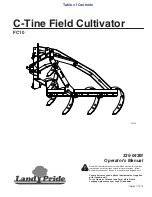
8 - WATER CONNECTIONS
8.3 - Cavitation protection (with hydronic
option)
To ensure the durability of pumps fitted on the integrated hydronic
modules, the control algorithm of units in the range includes
protection against cavitation.
It is therefore necessary to ensure a minimum pressure of 60
kPa (0.6 bar) at the pump inlet both when shut down and during
operation.
A pressure below 60 kPa will prevent unit start-up, or will cause
an alarm and shut-down.
A pressure below 100 kPa will trigger an alert on the user
interface.
To obtain an adequate pressure, it is recommended:
-
To pressurise the hydraulic circuit between 100 kPa (1 bar)
and 400 kPa (4 bar) maximum at the pump inlet;
-
To clean the hydraulic circuit during water filling or after any
modifications are made;
-
To regularly clean the screen filter.
8.4 - Flow rate detection
Standard machine
All units are equipped as standard with a factory-set flow switch.
It cannot be adjusted on site.
The heat-transfer fluid pump must be servo-controlled by the
assembly if the unit is not equipped with the hydronic module
option. Dedicated terminals are provided for installing the heat-
transfer fluid pump servo control (auxiliary operation switch of
the pump to be wired on site).
Machine with hydronic module (option)
The “flow rate detection” functionality is handled by the option
via the pressure sensors.
8.5 - Frost protection
Damage caused by frost is not covered by the
warranty.
The plate exchangers, the pipes, the buffer tank pump(s) and
the hydronic module pumps can be damaged by frost. The
components of the unit (heat exchanger, pipes, hydronic module,
buffer tank module) will be protected by following the
recommendations below. Protection of the remainder of the
system is the responsibility of the installer.
The plate heat exchanger and all the components of the water
circuit can be protected against freezing by draining the entire
machine completely, checking that there are no retention points.
If this is not possible, the plate heat exchanger and all the
components of the water circuit can be protected against freezing:
-
Down to -20°C by heaters and heat trace cables (fitted as an
option on the exchanger and internal pipe system) supplied
automatically (for units without the hydraulic module).
-
Down to -20°C by heaters and heat trace cables (fitted as an
option on the exchanger, buffer tank module (option) and
internal pipe system) supplied automatically and pump
circulation (for units with the hydronic module)
If the water heat exchanger connection sleeves option is also
ordered, it is necessary to install a heater on each extension in
order to protect the water pipes down to outdoor temperatures
of -20°C.
Never power off the heaters for the water exchanger and the
water circuit or pump, as they will no longer be providing frost
protection.
To ensure they continue to receive power, the main switch for
the unit or the customer's circuit and the auxiliary circuit breaker
for the heaters must be left closed (see the wiring diagram for
the location of these components).
To protect units with a hydronic module from freezing, water must
be circulated in the water circuit by the pump, which is activated
at regular intervals.
Combination of options for the periods when the machine is
in standby mode
Ambient temperature
range
AQUACIAT
POWER
ILD ST / HE 602-2000
without "Hydronic
module" option
with "Hydronic module"
option
> 0°C to 48°C
-
-
-20°C to 0°C
Water exchanger frost
protection option
or
Appropriate antifreeze
solution (for example glycol)
Water exchanger and
hydraulic module antifreeze
protection option
(1)
or
Appropriate antifreeze
solution (for example glycol)
(1)
(1) Allow the pumps to circulate. If there is a valve, install a bypass (see diagram
for winter position).
If the system is isolated by a valve, it is imperative to install a
bypass as indicated below.
Winter position
Unit
Water system
closed
closed
open
IMPORTANT:
Depending on the atmospheric conditions in your region, you
need to:
-
Add an appropriate antifreeze solution (maximum of 45%) to
protect the system down to a temperature of 10 K below the
lowest temperature likely to occur locally.
-
For extended shut-downs, drain and add an anti-freeze
solution to the heat exchanger (use the drain valve located
at the water inlet).
-
To prevent corrosion due to differential aeration, if the system
is to be empty for more than 1 month, the heat-transfer fluid
circuit should be protected with a blanket of neutral gas (0.5
bar maximum). If the heat-transfer fluid does not meet the
recommendations, a nitrogen blanket must be applied
immediately.
-
At the start of the next season, refill the unit with water and
add an inhibitor.
-
If additional equipment is added to the system, the installer
must comply with the basic recommendations, especially the
minimum and maximum flow rates which must be between the
values shown in the operating limits table (application data).
-
If frost protection is dependent on electric heaters, never
deenergize the unit when frost protection is required. To
ensure protection, the main unit disconnect switch and the
auxiliary heater protection circuit breaker must be closed (see
wiring diagram to locate these components). If it is not to be
used in freezing conditions, or during a prolonged period
without power (whether or not this is scheduled), the water
exchanger and external pipes must be drained immediately
-
In case of prolonged non-usage, the hydraulic circuits must
be protected by circulating a passivating solution. (Consult a
specialist).
-
The exchanger temperature sensors are an essential frost
protection element: if piping trace heaters are used, ensure
the external heaters do not affect the measurements provided
by these sensors.
-
If auxiliary equipment is installed in the system, the installer
must ensure that the resultant flow rates are still within the
minimum and maximum values indicated in the operating
limits table (application data).
AQUACIAT
POWER
ILD
EN-34
















































